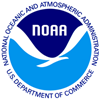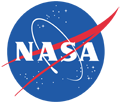Planets and Moons
ID: 10477
NASA's home for spherical films on Magic Planet. Download the Magic Planet-ready movie file here.
Three hundred and eighty million miles from Earth, the solar system's largest planet spins like a sizzling top in the night, massive and powerful beyond all comparison short of the sun itself. It's therefore only fitting—and certainly about time—that the fifth planet receive its proper cinematic due, set naturally on the most appropriate cinematic platform. With the movie LARGEST, Jupiter comes to Science On a Sphere.
LARGEST examines the gas giant like a work of art, like a destination of celestial wonder. Starting with the basics, the movie examines the gross anatomy of the immense planet. From swirling winds to astounding rotational velocity to unimaginable size, Jupiter demands nothing less than a list of superlatives. But where general description sets the stage, LARGEST parts the curtains on humanity's experience with the fifth planet. The movie takes us on a journey to this immense sphere via dramatic fly-bys with some of the most astounding robotic probes ever designed. Then, with NASA instruments trained on the striped behemoth, the drama really begins.
NASA released LARGEST on September 15, 2009. It is one in a series of spherical movies created entirely by staff at the NASA Goddard Space Flight Center. But while the process to create a fully spherical movie is something of an in-house Goddard creation, the Science On a Sphere projection system itself is an invention of the space agency's sibling NOAA.
This film has been prepared exclusively for playback on spherical projections systems. It will not play properly on a traditional computer or television screen. If you are interested in downloading the complete final movie file for spherical playback, please visit ftp://public.sos.noaa.gov/extras/.
For more information about the movie itself, visit the main website at www.nasa.gov/largest.
Official Movie Credits:
Written, Produced & Directed by Michael Starobin Edited by Victoria Weeks Narrated by Chris Meaney Motion Graphics Victoria Weeks The Scientific Visualization Studio/NASA GSFC Director of Data Visualization Horace Mitchell Visualization Team Greg Shirah Tom Bridgman Ernest Wright Lori Perkins Software Development Greg Shirah Eric Sokolowsky Sound Design, Incidental Music Michael Starobin Computer Voice Mara Bayewitz Animation Walt Feimer IT Management Pankaj Jaiswal Jim Williams Stuart Snodgrass Recording Engineer Mike Velle Account Management Mike Velle Science On a Sphere Project Liaison Maurice Henderson Scientific Consultants Dr. Amy Simon-Miller, GSFC Dr. David R. Williams, GSFC Educational Content Development Sallie Smith, Pamela Clark Other Contributors Steve Albers, NOAA Reta Beebe, New Mexico State University Gordon Bjoraker, GSFC Shawn Ewald, Caltech/JPL Brendan Fisher, Caltech/JPL Heidi B. Hammel, Space Science Institute Andy Ingersoll, Caltech/JPL Allen Lunsford, Catholic University/GSFC Louis Mayo, HTSI/GSFC Glenn S. Orton, Caltech/JPL Carolyn Porco, Space Science Institute Dennis Reuter, GSFC Michael D. Smith, GSFC Ashwin R. Vasavada, Caltech/JPL Keith Noll, Space Telescope Science Institute Microscopic Footage Peter A. Siver, Department of Botany, Connecticut College, New London, Connecticut Music Ludwig van Beethoven, Symphony No. 9, 2nd Movement Op. 125 Ludwig van Beethoven, Symphony No. 2, 2nd Movement Op. 36 Felix Mendelssohn, The Hebrides Overture, Op. 26 Felix Mendelssohn, Symphony No. 4 3rd Movement, Op. 90 Dr. Keith J. Salmon, Conductor Shockwave-sound.com Additional Thanks Mika and Tamara Kostamo NASA Cassini Imaging Team Cosmos Studios Wayne Lanier NASA Opportunities in Education & Public Outreach for Earth and Space Science Program The NASA New Horizons Mission Executive Producer for Honeywell Technology Solutions Patrick Kennedy Executive Producer for NASA Television, GSFC Wade Sisler Science On a Sphere was Developed by NOAA LARGEST
LARGEST
 It's good to be king.
Copyright © 2009
NASA Goddard Space Flight Center
It's good to be king.
Copyright © 2009
NASA Goddard Space Flight Center
LARGEST: A Spherical Movie About Jupiter
Three hundred and eighty million miles from Earth, the solar system's largest planet spins like a sizzling top in the night, massive and powerful beyond all comparison short of the sun itself. It's therefore only fitting—and certainly about time—that the fifth planet receive its proper cinematic due, set naturally on the most appropriate cinematic platform. With the movie LARGEST, Jupiter comes to Science On a Sphere.
LARGEST examines the gas giant like a work of art, like a destination of celestial wonder. Starting with the basics, the movie examines the gross anatomy of the immense planet. From swirling winds to astounding rotational velocity to unimaginable size, Jupiter demands nothing less than a list of superlatives. But where general description sets the stage, LARGEST parts the curtains on humanity's experience with the fifth planet. The movie takes us on a journey to this immense sphere via dramatic fly-bys with some of the most astounding robotic probes ever designed. Then, with NASA instruments trained on the striped behemoth, the drama really begins.
NASA released LARGEST on September 15, 2009. It is one in a series of spherical movies created entirely by staff at the NASA Goddard Space Flight Center. But while the process to create a fully spherical movie is something of an in-house Goddard creation, the Science On a Sphere projection system itself is an invention of the space agency's sibling NOAA.
This film has been prepared exclusively for playback on spherical projections systems. It will not play properly on a traditional computer or television screen. If you are interested in downloading the complete final movie file for spherical playback, please visit ftp://public.sos.noaa.gov/extras/.
For more information about the movie itself, visit the main website at www.nasa.gov/largest.
For More Information
Credits
Victoria Weeks (HTSI): Animator
Greg Shirah (NASA/GSFC): Animator
Tom Bridgman (Global Science and Technology, Inc.): Animator
Ernie Wright (UMBC): Animator
Lori Perkins (NASA/GSFC): Animator
Walt Feimer (HTSI): Animator
Victoria Weeks (HTSI): Video Editor
Chris Meaney (HTSI): Narrator
Michael Starobin (HTSI): Producer
Amy A. Simon (NASA/GSFC): Scientist
David R. Williams (NASA/GSFC): Scientist
Pankaj K. Jaiswal (SAIC): Project Support
James W. Williams (GST): Project Support
Stuart A. Snodgrass (HTSI): Project Support
Michael Starobin (HTSI): Writer
Greg Shirah (NASA/GSFC): Animator
Tom Bridgman (Global Science and Technology, Inc.): Animator
Ernie Wright (UMBC): Animator
Lori Perkins (NASA/GSFC): Animator
Walt Feimer (HTSI): Animator
Victoria Weeks (HTSI): Video Editor
Chris Meaney (HTSI): Narrator
Michael Starobin (HTSI): Producer
Amy A. Simon (NASA/GSFC): Scientist
David R. Williams (NASA/GSFC): Scientist
Pankaj K. Jaiswal (SAIC): Project Support
James W. Williams (GST): Project Support
Stuart A. Snodgrass (HTSI): Project Support
Michael Starobin (HTSI): Writer
Written, Produced & Directed by Michael Starobin Edited by Victoria Weeks Narrated by Chris Meaney Motion Graphics Victoria Weeks The Scientific Visualization Studio/NASA GSFC Director of Data Visualization Horace Mitchell Visualization Team Greg Shirah Tom Bridgman Ernest Wright Lori Perkins Software Development Greg Shirah Eric Sokolowsky Sound Design, Incidental Music Michael Starobin Computer Voice Mara Bayewitz Animation Walt Feimer IT Management Pankaj Jaiswal Jim Williams Stuart Snodgrass Recording Engineer Mike Velle Account Management Mike Velle Science On a Sphere Project Liaison Maurice Henderson Scientific Consultants Dr. Amy Simon-Miller, GSFC Dr. David R. Williams, GSFC Educational Content Development Sallie Smith, Pamela Clark Other Contributors Steve Albers, NOAA Reta Beebe, New Mexico State University Gordon Bjoraker, GSFC Shawn Ewald, Caltech/JPL Brendan Fisher, Caltech/JPL Heidi B. Hammel, Space Science Institute Andy Ingersoll, Caltech/JPL Allen Lunsford, Catholic University/GSFC Louis Mayo, HTSI/GSFC Glenn S. Orton, Caltech/JPL Carolyn Porco, Space Science Institute Dennis Reuter, GSFC Michael D. Smith, GSFC Ashwin R. Vasavada, Caltech/JPL Keith Noll, Space Telescope Science Institute Microscopic Footage Peter A. Siver, Department of Botany, Connecticut College, New London, Connecticut Music Ludwig van Beethoven, Symphony No. 9, 2nd Movement Op. 125 Ludwig van Beethoven, Symphony No. 2, 2nd Movement Op. 36 Felix Mendelssohn, The Hebrides Overture, Op. 26 Felix Mendelssohn, Symphony No. 4 3rd Movement, Op. 90 Dr. Keith J. Salmon, Conductor Shockwave-sound.com Additional Thanks Mika and Tamara Kostamo NASA Cassini Imaging Team Cosmos Studios Wayne Lanier NASA Opportunities in Education & Public Outreach for Earth and Space Science Program The NASA New Horizons Mission Executive Producer for Honeywell Technology Solutions Patrick Kennedy Executive Producer for NASA Television, GSFC Wade Sisler Science On a Sphere was Developed by NOAA
 LARGEST
LARGEST
 It's good to be king.
Copyright © 2009
NASA Goddard Space Flight Center
It's good to be king.
Copyright © 2009
NASA Goddard Space Flight Center
Short URL to share this page:
https://svs.gsfc.nasa.gov/10477
Missions:
SOHO
Terra
Voyager
Data Used:
Note: While we identify the data sets used in these visualizations, we do not store any further details nor the data sets themselves on our site.
This item is part of these series:
Narrated Movies
Science On a Sphere
Goddard Best of 2009 Film Festival
Goddard Magic Planet Media
Keywords:
SVS >> HDTV
SVS >> Jupiter
SVS >> Science On a Sphere
SVS >> Planets
DLESE >> Narrated
SVS >> Voice Over Talent
NASA Science >> Planets and Moons
https://svs.gsfc.nasa.gov/10477
Missions:
SOHO
Terra
Voyager
Data Used:
Terra and Aqua/MODIS/Blue Marble: Next Generation also referred to as: BMNG
May
Credit:
The Blue Marble data is courtesy of Reto Stockli (NASA/GSFC).
The Blue Marble data is courtesy of Reto Stockli (NASA/GSFC).
JPL/Horizon Orbital Ephemerides
Ephemeris - NASA/JPL - 2007/11/23 to 2011/07/02
Planetary ephemerides
CPC (Climate Prediction Center) Cloud Composite
Data Compilation - Climate Prediction Center (CPC) - 2007/06/29 to 2007/07/19
Global cloud cover from multiple satellites
Simulated Jupiter Wind Flow Field
Model - 2000also referred to as: Shoemaker-Levy 9 Comet Fragment Ephemerides
Ephemeris - 1994/06/17 to 1994/08/01Cassini/Imaging Science Subsystem also referred to as: Cassini/Jupiter imagery
Mosaic - Cassini Imagery/Central Laboratory for OPerations - 2000
Cassini/Jupiter imagery
Voyager-1/Imaging Science Subsystem
MosaicVoyager-2/Imaging Science Subsystem
MosaicThis item is part of these series:
Narrated Movies
Science On a Sphere
Goddard Best of 2009 Film Festival
Goddard Magic Planet Media
Keywords:
SVS >> HDTV
SVS >> Jupiter
SVS >> Science On a Sphere
SVS >> Planets
DLESE >> Narrated
SVS >> Voice Over Talent
NASA Science >> Planets and Moons











